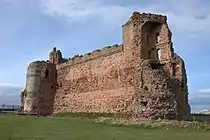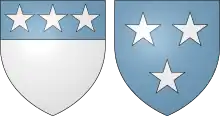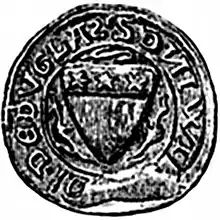Earl of Douglas
This page is concerned with the holders of the forfeit title Earl of Douglas and the preceding feudal barons of Douglas, South Lanarkshire. The title was created in the Peerage of Scotland in 1358 for William Douglas, 1st Earl of Douglas, son of Sir Archibald Douglas, Guardian of Scotland. The Earldom was forfeited by James Douglas, 9th Earl of Douglas, in 1455.



Origins
Mythic beginnings
The Earls of Douglas, chiefs of Clan Douglas, and their successors claimed descent from Sholto Douglas, a mythical figure dated by Godscroft to 767 AD.[1] However, it is more likely that they were descendants of Flemish immigrants to Scotland, during the reign of David I.[2] Through the marriage of William the Hardy, grandfather of the 1st Earl, to Eleanor de Lovaine, the Earls of Douglas could trace their ancestry to the Landgraves of Brabant. In the story of Sholto Douglas, his son William Douglas is a commander of forces sent by the mythical Scottish king Achaius (Eochaid?), to the court of Charlemagne to aid him in his wars against Desiderius, King of the Lombards. William Douglas is said to have settled in Piacenza where his descendants became powerful local magnates under the name Scotti (or Scoto), and eventual leaders of the Guelf faction of that city.[3]
Historicity


The first Douglas on record in Scotland is William I, Lord of Douglas (c. 1174-1214), where he was witness to a charter of bishop Jocelin of Glasgow in 1198, where he signed "Will. de Dufglas" in what can only be a territorial designation.[4] It can be deduced however, that there was a connection to the House of Moray and its progenitor, Freskin, Lord of Duffus, insofar as the later blazon of both Houses both contained three stars argent on a field azure; further in a document pertaining to Bricius de Douglas, William of Douglas's son and Bishop of Moray, he refers to his avunculus Freskin of Kerdal, an unusual name for the time in Scotland.[5] This connection with the Morays can be later attested in a rhyme penned by Andrew of Wyntoun around the time of the marriage of Archibald the Grim to Johanna de Moravia the Moray heiress, of which further below:
Of Murrawe and the Douglas,
How that thare begynnyng was,
Syn syndry spekis syndryly
I can put that in na story.
But in thare armeyis bath thai bere
The sternys[stars] set in lyke manere;
Til mony men it is yhit sene
Apperand lyk that had bene
Of kyn be descens lyneale
Or be branchys collaterele[6]
Famous art works
In the early 16th century Charles II D'Amboise commissioned Bernardino de' Conti to do a portrait painting for him in 1505 AD.[7] Although a friend and patron of Leonardo Da Vinci, D'Amboise picked de' Conti for his traditional style of oil painting.
Prominently inscribed on the top left the painting reads, "The Earl of Douglas surnamed Black Dudley" (referring to James, Lord of Douglas).
It is unknown how many renditions de' Conti created, but there is one that resides in the Seattle Art Museum, another once owned by Henry VIII belongs to the Royal Family,[8] and at least one belongs in a private collection.
Rise to power
Sir William the Hardy is the first of the Douglas Lords on record to take a major part in domestic and international affairs. He partook in Wallace's uprising against English rule in Scotland and died captive in the Tower of London.[9] His son Sir James Douglas, his estates forfeit to the English crown, swore allegiance to Robert the Bruce in 1306 prior to the latter's coronation, and was to share the deprivations and small victories of Bruce during the years leading up to Bannockburn. Afterwards he was appointed Warden of the Western March on the Scottish Border. Following Bruce's death, Sir James Douglas, now known as either "the Black Douglas" to the English, or the "Good Sir James" to the Scots, took the King's heart on crusade, and died fighting the Moors in Spain.[10]
Earldom of Douglas
The Good Sir James's nephew William, Lord of Douglas was created 1st Earl of Douglas in 1358, and greatly increased Douglas territory by marrying Margaret, Countess of Mar. The creation of the Earldom can be accurately dated to 26 January that year, because of a charter witnessed by Douglas on the 25 January where he is described as "William, Lord of Douglas, Knight", and another of the 27th of the month as the Earl of Douglas.[11][12] The power of Douglas was further increased by the marriage of the 2nd Earl to Princess Isabel, daughter to Robert II of Scotland. The acme of Douglas territorial power came when Archibald the Grim, Lord of Galloway a bastard son of the Good Sir James inherited the Earldom following the 2nd Earl's death at the Battle of Otterburn. "Black Archibald" as he was also known, was by right of conquest Lord of Galloway; and by right of his wife, the Moray heiress Joanna de Moravia, the Lord of Bothwell and its vast entail. Already one of the largest landowners in the realm, Archibald the Grim was now the greatest Tenant-in-chief of the Scottish Crown.
William, the 1st Earl, Archibald the Grim and both his son the 4th Earl and grandson, the 5th Earl fought in France as well as the along the Anglo-Scottish Border, during what would become known as the Hundred Years War. The 1st Earl and the 3rd were both present at the Battle of Poitiers, and the future 5th Earl Archibald, Earl of Wigtown was a deputy of John Stewart, Earl of Buchan at the Battle of Baugé and elsewhere. Archibald Douglas, 4th Earl of Douglas, had fought at Homildon Hill, was captured there and then joined the rebel Northern English Barons to fight at Battle of Shrewsbury where he was again captured. It was during this episode of his life that Douglas makes an appearance as one of the characters in William Shakespeare's Henry IV, Part 1. In 1423 Douglas's son Wigtown, returned to Scotland to raise more troops for the French war and managed to enlist his father's support, the 4th Earl sailed for France with an army some 6,500 strong, was created Duke of Touraine and Lieutenant General of France by a grateful Dauphin. Douglas was killed at Battle of Verneuil in 1424. The 5th Earl of Douglas upon his accession was sometime regent of Scotland during the minority of James II of Scotland and Lieutenant-General of Scotland.
The 5th Earl's sons, the sixteen-year-old William Douglas, 6th Earl of Douglas and his brother David Douglas, were to be victim to the cabal of Sir William Crichton, Sir Alexander Livingston of Callendar, and their great uncle James Douglas, Earl of Avondale who wished to break the power of the Black Douglases. The boys were summoned to Edinburgh Castle, and where at what is known as the "Black Dinner" the Earl and his brother were taken into the Castleyard and executed before the young king.[13]
Downfall of the Black Douglases
The Earl of Avondale, the boys' great uncle and supposed conspirator into their deaths, became the 7th Earl of Douglas; known as "James the Gross" he inherited all the Douglas patrimony and died in 1443. Far from breaking Douglas power, the death of the 6th Earl consolidated it into the hands of the five formidable sons of James the Gross. James II of Scotland, exasperated at his overmighty vassal, William Douglas, 8th Earl of Douglas, and his refusal to break a league entered into with the Earl of Crawford and John of Islay, stabbed him to death with his own hands, even though Douglas had been issued a safe conduct. Douglas's brothers, James Douglas, 9th Earl of Douglas, Archibald Douglas, Earl of Moray, Hugh Douglas, Earl of Ormonde, and John Douglas, Lord of Balvenie went into open rebellion against the Crown, but were finally put down in a skirmish in 1455 known as the Battle of Arkinholm; the royal forces were led by another Douglas, the "Red" George Douglas, 4th Earl of Angus. The Douglas brothers were all slain, either in battle or executed afterwards, except the 9th Earl who was in England at the time. The 9th Earl was forfeited, but continued to foment unrest in Scotland from England, until his capture at the Battle of Lochmaben Fair in 1484. The aged Douglas was forced to spend the rest of his days at Lindores Abbey, his estates being divided up between the King's supporters, most notably Angus.
Black and Red Douglases
Following the death of the 2nd Earl at the Battle of Otterburn in 1388 without legitimate issue, the Earldom passed to a bastard son of "The Good Sir James", the poetically named Archibald the Grim, the Lord of Galloway. This occurred through articles of special entail in the resignation of title by Hugh the Dull, Lord of Douglas. George Douglas, 1st Earl of Angus the bastard son of the 1st Earl by his sister-in law Margaret Stewart, Dowager Countess of Mar & Countess of Angus, inherited his mother's Earldom of Angus. Retrospectively the two branches of Douglas and Angus were described as the Black and Red lines respectively.
The Black Douglases fell from power and were attainted by King James II in 1455. The seventh Earl was created Earl of Avondale and Lord Balveny in 1437, also in the Peerage of Scotland. These titles also became forfeit in 1455.
The title of Douglas was restored in 1633 for the "Red" Douglas line, when William Douglas, 11th Earl of Angus (1589–1660), was created First Marquess of Douglas by Charles I.
Lords of Douglas
- William I, Lord of Douglas (died c. 1214)
- Archibald I, Lord of Douglas (died c. 1240)
- William Longleg, Lord of Douglas (c. 1220–c. 1274)
- William 'The Hardy', Lord of Douglas (c. 1240–1298) Died captive in the Tower of London
- James 'The Good', Lord of Douglas (c. 1290–1330) Killed at the Battle of Teba
- William IV, Lord of Douglas (died 1333) Killed at the Battle of Halidon Hill
- Hugh the Dull, Lord of Douglas (1294–c. 1345) resigned Lordship 1342
- William, Lord of Douglas (1327–1384) Created first Earl 1358.
Earls of Douglas (1358)
- William Douglas, 1st Earl of Douglas (1327–1384)
- James Douglas, 2nd Earl of Douglas (1358–1388), killed at the Battle of Otterburn
- Archibald Douglas, Lord of Galloway, 3rd Earl of Douglas (1325–1400) "the Grim", Bastard cousin of the 1st Earl, created Earl of Wigtown[14] 1372
- Archibald Douglas, 4th Earl of Douglas (1370–1424) Duke of Touraine, killed at the Battle of Verneuil
- Archibald Douglas, 5th Earl of Douglas (1390–1439), son of the above
- William Douglas, 6th Earl of Douglas (1426–1440), Murdered at the Black Dinner at Edinburgh Castle
- James Douglas, 7th Earl of Douglas (died 1443) "the Gross" created Earl of Avondale in 1437, murderer and great-uncle of above.
- William Douglas, 8th Earl of Douglas and 2nd Earl of Avondale (1425–1452), Murdered by James II of Scotland at Stirling Castle.
- James Douglas, 9th Earl of Douglas and 3rd Earl of Avondale (died 1488), the last "Black Douglas", brother of the previous, attainted 1455 and all his titles forfeit.
Lordship of Douglas, and other estates and title devolved upon: George Douglas, 4th Earl of Angus
Other titles held
The following titles were held by the Earl of Douglas, at various times.
- Dukedom of Touraine
- Earldom of Mar
- Earldom of Wigtown
- Earldom of Avondale
- Lordship of Balvenie- subsidiary title of Lord Avondale
- Earldom of Moray
- Earl of Ormonde
- Lordship of Annandale
- Lordship of Galloway
- County of Longueville
- Seigneurie of Dun-le-Roi
Family tree
| Family tree of the: Earls of Angus, Earls of Avondale, Earls of Douglas, Marquesses of Douglas, Earls of Forfar and Earls and Marquesses of Ormond | |||||||||||||||||||||||||||||||||||||||||||||||||||||||||||||||||||||||||||||||||||||||||||||||||||||||||||||||||||||||||||||||||||||||||||||||||||||||||||||||||||||||||||||||||||||||||||||||||||||||||||||||||||||||||||||||||||||||||||||||||||||||||||||||||||||||||||||||||||||||||||||||||||||||||||||||||||||||||||||||||||||||||||||||||||||||||||||||||||||||||||||||||||||||||||||||||||||||||||||||||||||||||||||||||||||||||||||||||||||||||||||||||||||||||||||||||||||||||||||||||||||||||||||||||||||||||||||||||||||||||||||||||||||||||||||||||||||||||||||||||||||||||||||||||||||||||||||||||||||||||||||||||||||||||||||||||||||||||||||||||||||||||||||||||||||||||||||||||||||||||||||||||||||||||||||||||||||||||||||||||||||||||||||||||||||||||||||||||||||||||||||||||||||||||||||||||||||||||||||||||||||||||||||||||||||||||||||||||||||||||||||||||||||||||||||||||||||||||||||||||||||||||||||||||||||||||||||||||||||||||||||||||||||||||||||||||||||||||||||||||||||||||||||||||||||||||||||||||||||||
|---|---|---|---|---|---|---|---|---|---|---|---|---|---|---|---|---|---|---|---|---|---|---|---|---|---|---|---|---|---|---|---|---|---|---|---|---|---|---|---|---|---|---|---|---|---|---|---|---|---|---|---|---|---|---|---|---|---|---|---|---|---|---|---|---|---|---|---|---|---|---|---|---|---|---|---|---|---|---|---|---|---|---|---|---|---|---|---|---|---|---|---|---|---|---|---|---|---|---|---|---|---|---|---|---|---|---|---|---|---|---|---|---|---|---|---|---|---|---|---|---|---|---|---|---|---|---|---|---|---|---|---|---|---|---|---|---|---|---|---|---|---|---|---|---|---|---|---|---|---|---|---|---|---|---|---|---|---|---|---|---|---|---|---|---|---|---|---|---|---|---|---|---|---|---|---|---|---|---|---|---|---|---|---|---|---|---|---|---|---|---|---|---|---|---|---|---|---|---|---|---|---|---|---|---|---|---|---|---|---|---|---|---|---|---|---|---|---|---|---|---|---|---|---|---|---|---|---|---|---|---|---|---|---|---|---|---|---|---|---|---|---|---|---|---|---|---|---|---|---|---|---|---|---|---|---|---|---|---|---|---|---|---|---|---|---|---|---|---|---|---|---|---|---|---|---|---|---|---|---|---|---|---|---|---|---|---|---|---|---|---|---|---|---|---|---|---|---|---|---|---|---|---|---|---|---|---|---|---|---|---|---|---|---|---|---|---|---|---|---|---|---|---|---|---|---|---|---|---|---|---|---|---|---|---|---|---|---|---|---|---|---|---|---|---|---|---|---|---|---|---|---|---|---|---|---|---|---|---|---|---|---|---|---|---|---|---|---|---|---|---|---|---|---|---|---|---|---|---|---|---|---|---|---|---|---|---|---|---|---|---|---|---|---|---|---|---|---|---|---|---|---|---|---|---|---|---|---|---|---|---|---|---|---|---|---|---|---|---|---|---|---|---|---|---|---|---|---|---|---|---|---|---|---|---|---|---|---|---|---|---|---|---|---|---|---|---|---|---|---|---|---|---|---|---|---|---|---|---|---|---|---|---|---|---|---|---|---|---|---|---|---|---|---|---|---|---|---|---|---|---|---|---|---|---|---|---|---|---|---|---|---|---|---|---|---|---|---|---|---|---|---|---|---|---|---|---|---|---|---|---|---|---|---|---|---|---|---|---|---|---|---|---|---|---|---|---|---|---|---|---|---|---|---|---|---|---|---|---|---|---|---|---|---|---|---|---|---|---|---|---|---|---|---|---|---|---|---|---|---|---|---|---|---|---|---|---|---|---|---|---|---|---|---|---|---|---|---|---|---|---|---|---|---|---|---|---|---|---|---|---|---|---|---|---|---|---|---|---|---|---|---|---|---|---|---|---|---|---|---|---|---|---|---|---|---|---|---|---|---|---|---|---|---|---|---|---|---|---|---|---|---|---|---|---|---|---|---|---|---|---|---|---|---|---|---|---|---|---|---|---|---|---|---|---|---|---|---|---|---|---|---|---|---|---|---|---|---|---|---|---|---|---|---|---|---|---|---|---|---|---|---|---|---|---|---|---|---|---|---|---|---|---|---|---|---|---|---|---|---|---|---|---|---|---|---|---|---|---|---|---|---|---|---|---|---|---|---|---|---|---|---|---|---|---|---|---|---|---|---|---|---|---|---|---|---|---|---|---|---|---|---|---|---|---|---|---|---|---|---|---|---|---|---|---|---|---|---|---|---|---|---|---|---|---|---|---|---|---|---|---|---|---|---|---|---|---|---|---|---|---|---|---|---|---|---|---|---|---|---|---|---|---|---|---|---|---|---|---|---|---|---|---|---|---|---|---|---|---|---|---|---|---|---|---|---|---|---|---|---|---|---|---|---|---|---|---|---|---|---|---|---|---|---|---|---|---|---|---|---|---|---|---|---|---|---|---|---|---|---|---|---|---|---|---|---|---|---|---|---|---|---|---|---|---|---|---|---|---|---|---|---|---|---|---|---|---|---|---|---|---|---|---|---|---|---|---|---|---|---|---|---|---|---|---|---|---|---|---|---|---|---|---|---|---|---|---|---|---|---|---|---|---|---|---|---|---|---|---|---|---|---|---|---|---|---|---|---|---|---|---|---|---|---|---|---|---|---|---|---|---|---|---|---|---|---|---|---|---|---|---|---|---|---|---|---|---|---|---|---|---|---|---|---|---|---|---|---|---|---|---|---|---|---|---|---|---|---|---|---|---|---|---|---|---|---|---|---|---|---|---|---|---|---|---|---|---|---|---|---|
| |||||||||||||||||||||||||||||||||||||||||||||||||||||||||||||||||||||||||||||||||||||||||||||||||||||||||||||||||||||||||||||||||||||||||||||||||||||||||||||||||||||||||||||||||||||||||||||||||||||||||||||||||||||||||||||||||||||||||||||||||||||||||||||||||||||||||||||||||||||||||||||||||||||||||||||||||||||||||||||||||||||||||||||||||||||||||||||||||||||||||||||||||||||||||||||||||||||||||||||||||||||||||||||||||||||||||||||||||||||||||||||||||||||||||||||||||||||||||||||||||||||||||||||||||||||||||||||||||||||||||||||||||||||||||||||||||||||||||||||||||||||||||||||||||||||||||||||||||||||||||||||||||||||||||||||||||||||||||||||||||||||||||||||||||||||||||||||||||||||||||||||||||||||||||||||||||||||||||||||||||||||||||||||||||||||||||||||||||||||||||||||||||||||||||||||||||||||||||||||||||||||||||||||||||||||||||||||||||||||||||||||||||||||||||||||||||||||||||||||||||||||||||||||||||||||||||||||||||||||||||||||||||||||||||||||||||||||||||||||||||||||||||||||||||||||||||||||||||||||||
Seals of the Douglas Lords
 Seal of William le Hardi, Lord of Douglas
Seal of William le Hardi, Lord of Douglas Seal attributed to William, 1st Earl of Douglas,
Seal attributed to William, 1st Earl of Douglas, Seal of Archibald the Grim, 3rd Earl of Douglas
Seal of Archibald the Grim, 3rd Earl of Douglas Seal of the 4th Earl of Douglas, Duke of Touraine
Seal of the 4th Earl of Douglas, Duke of Touraine
See also
Red Douglas
- Earl of Angus, later Marquess of Douglas and Duke of Douglas.
- This line is represented now by the Dukes of Hamilton, the heirs male of the House of Douglas.
Other lines
- Earl of Home (in the female line), in the capacity of Lord Douglas of that Ilk
- Earl of Queensberry (since 1633), later Marquess of Queensberry (since 1682) and Duke of Queensberry (1684—1810).
- Earl of Morton (since 1458)
- Baron Penrhyn (since 1866)
- Swedish-German Line: Descendants of Robert Douglas, Count of Skenninge (1611-1662)
Notes
- Godscroft, pp 1-6
- Maxwell, Vol I, chap I, pp.1-12
- Godscroft, pp. 7-14
- Liber de Calchou, p346
- Fraser, vol I, p.37
- Wyntoun, Andrew of, Book VIII, Chap. VII,p. 320-321
- Seattle Art Museum. "Charles d'Amboise Portrait by Bernardino de' Conti". localhost. Retrieved 5 September 2021.
{{cite web}}: Check|url=value (help) - Royal Collection Trust. "The Earl of Douglas Surnamed Black". Archived from the original on 5 September 2021.
- Dictionary of National Biography (1885-1900 ed.). p. 15:354–55.
- Dictionary of National Biography (1885-1900 ed.). p. 15:301–304. Retrieved 29 August 2016.
- Maxwell, Vol.I, p.81
- Fraser Vol.I, p.234
- Dictionary of National Biography (1885-1900 ed.). p. 16:361. Retrieved 29 August 2016.
- Maxwell, VolI, p118
References
- Brown Michael. The Black Douglases-War and Lordship in late Medieval Scotland. East Linton 1998
- Fraser, Sir William, The Douglas Book IV vols. Edinburgh 1885.
- Godscroft, David Hume of. The History of the House and Race of Douglas and Angus. London 1820
- Maxwell, Sir Herbert. A History of the House of Douglas II Vols. London 1902
- Wyntoun, Andrew of, Orygynale Cronikyl of Scotland, ed. Laing. Edinburgh 1872.